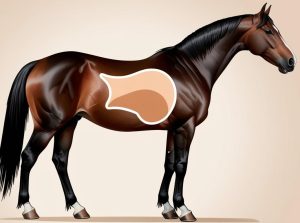
The percentage of horses diagnosed with stomach ulcers has skyrocketed in the last decade. The current state-of-the-art approach is to administer omeprazole (Gastroguard®) to these horses for 30 days, in the morning on an empty stomach, as instructed by the manufacturer’s label. However, this therapy often fails, or the horses’ conditions even worsen. Are there any side effects? The answer is yes, and it depends on the time of day when the medication is given. In this article, I will explain why it is important to administer omeprazole at or after the horse’s dinner.
The mechanism of Omeprazole and the importance of stomach acid
It is crucial to understand when and how long the medication works. Omeprazole belongs to a group of drugs called H+ proton pump blockers. The H+ proton pump, in simple terms, is an acid pump in the stomach wall. When blocked, no stomach acid is released. The current belief is that stomach acid is entirely bad and must be eliminated completely to enable a stomach ulcer to heal. While it is true that reducing stomach acid aids in the healing of a stomach ulcer, there is a problem. Nature invents nothing without a reason. The purpose of stomach acid is to facilitate the digestion and absorption of nutritional elements such as protein, which requires a pH of around 2. The pH indicates how acidic the stomach content is; the lower the pH, the more acid is present. Therefore, a significant amount of stomach acid is necessary for protein digestion. Stomach acid is also required to digest starches, fats, supplements, and medications. If no stomach acid is present, none of these nutritional components can be absorbed, initiating a harmful chain reaction. One of the side effects is hindgut ulcers, as the unabsorbed feed reaches the hindgut and disrupts the microbiome, causing dysbiosis, followed by hindgut acidosis, and resulting in hindgut ulcers, which are then treated with another medication. Consequently, hindgut ulcers are often diagnosed in horses treated for stomach ulcers.
How and when does omeprazole inhibit nutrient absorption?
Pharmacokinetics of Omeprazole
After orally administering 2.3g of omeprazole (the content of one syringe of Gastroguard®), the medication does not begin to take effect until an hour or two later. This delay occurs because omeprazole is not a stomach acid buffer like calcium carbonate, found in Tums®. Stomach acid buffers start working immediately upon entering the stomach. However, the pharmacokinetics of omeprazole are more complex and time-consuming. The drug must first pass through the stomach, be absorbed in the foregut, enter the bloodstream, and then be transported back via the circulatory system to the stomach’s exterior. But once in effect, the drug blocks stomach acid for about 8-10 hours. Any feed other than grass hay, supplements or medication will not or only incompletely digested resp. absorbed. For that reason, horses treated with Omeprazole for months often lose their topline and muscle due to the inability to absorb protein.

Graph: After orally administering 2.3g of omeprazole the medication does not begin to take effect until an hour or two later. But once in effect, the Omeprazole blocks stomach acid for about 8-10 hours. This largely simplified graph shows serum levels for Omeprazole which parallel with its inhibitory effect on stomach acid. The numbers on the x-axis represent hours after application, with 0 as the application time.
The right timing: Off-label use
Based on the insights provided, it is advisable to administer Omeprazole at night after the dinner feeding. It is important to avoid feeding alfalfa after giving Omeprazole because it contains protein. Offering grass hay during the night is acceptable since grass hay is digested in the hindgut and does not require stomach acid. This method allows the horse to benefit from all the nutrition provided during the day, while the ulcers can heal on an empty stomach in the absence of stomach acid during the night.


